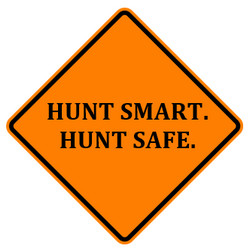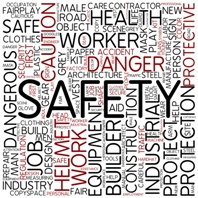Safety Never Takes A Holiday…Not in Hunting Season Either!
 In many places, the hunting season is underway or just beginning. This is always a time of change and hazard. Some years when I was a plant manager, we would have one or two serious hunting-related, off-job injuries – like falling from a tree stand or tripping over something and breaking a leg. There is a lot of change as people go into the woods and fields looking for game. Many have not done this for a while. Others may not be fully prepared for a sharp change in the weather where a heavy rain could come in or the temperatures drop below freezing and hypothermia becomes a worry. It is often dark and visibility is poor. I have read of hunters getting killed with their own weapon when they have tripped and accidentally shot themselves. Don’t load your gun until you are ready to use it.
In many places, the hunting season is underway or just beginning. This is always a time of change and hazard. Some years when I was a plant manager, we would have one or two serious hunting-related, off-job injuries – like falling from a tree stand or tripping over something and breaking a leg. There is a lot of change as people go into the woods and fields looking for game. Many have not done this for a while. Others may not be fully prepared for a sharp change in the weather where a heavy rain could come in or the temperatures drop below freezing and hypothermia becomes a worry. It is often dark and visibility is poor. I have read of hunters getting killed with their own weapon when they have tripped and accidentally shot themselves. Don’t load your gun until you are ready to use it.
There’s a certain excitement that pervades hunting season, especially with newbies to the sport, so hunting safety cautions and reminders are good to reinforce. Be especially careful and safety-instructive when you have hunting novices with you!
Safety never takes a holiday – not in hunting season either!
Checklists Really Can Save Lives!
 I have been talking about checklists in my previous newsletters and they can be useful as people go out hunting.
I have been talking about checklists in my previous newsletters and they can be useful as people go out hunting.
Consider this mental checklist:
- What sorts of special hazards do you face when you go out into nature and experience the thrill of the season?
- Are you alone?
- Do you have a flashlight if necessary?
- A compass?
- A cell phone?
- Do people know where you will be and when to expect you to return home again?
- Is your equipment really ready to do what you need?
- Are your weapons in excellent working order?
Too many questions????? My wife’s father died while he was doing what he loved – deer-hunting; but his heart was not strong enough for the exertion required in that terrain.
What about you? Are you healthy enough for the hunt? Do you have your emergency meds with you? Could you get help if you needed it?
Another change for many of you will be related to Thanksgiving and the travel to be with family. Here again checklists would be useful.
Consider this mental checklist:
- Is the car in good condition and serviced properly?
- For those up north, do you have a few blankets and emergency rations in case you get into a surprise storm?
- Are your maps and plans well thought out for the routes and times of travel?
- Are your tires in good shape?
- Do you have your ice scraper?
- Is your cell phone charged?
For the hunters and seasoned travelers, you probably have a pretty good fix on these things. However, in the hurry to get into the field and woods or get moving on your trip when people are anxious and a little uptight, it is easy to miss a critical thing. How many times in the past have you started out and remembered you left something important behind? A simple checklist, written or mental, could make a big, positive difference in your adventures! Remember, safety never takes a holiday!
Checklists in the Workplace
 I recently read of a fatal accident where a man was killed while working on a lathe. It was properly shielded and okay for the normal conditions, but the unexpected happened. The part he was working on exploded apart under the high rotating speed when he engaged the cutter. The parts from the exploding piece went right through the shield and gave him terrible, fatal wounds.
I recently read of a fatal accident where a man was killed while working on a lathe. It was properly shielded and okay for the normal conditions, but the unexpected happened. The part he was working on exploded apart under the high rotating speed when he engaged the cutter. The parts from the exploding piece went right through the shield and gave him terrible, fatal wounds.
As you get ready to start your jobs – talking together about being fully prepared – it is important to imagine the unimaginable. What unlikely thing can happen that can get one of you killed if things go in unexpected ways? For many of these unexpected events there are no safety procedures developed. They lurk just outside of the normal path of events for which we have plenty of rules.
We often discover these lurking tragedies by talking together and thinking out loud about things. This requires a culture where it is expected that you will talk together, listen carefully to what you are hearing, asking questions and being open to something new. Sometimes when two seemingly unrelated ideas come together new insights emerge that could reveal a potentially serious accident. Often when we are listening to comics, two seemingly unrelated ideas are put together can be really funny. Conversely, thinking of two, seemingly unrelated things or events could save a life.
Thinking about the unexpected can be a powerful thing. (Put that on your mental checklist!)
Backfilling: The Hazard of Temporary Workers
 Another thing that can happen around hunting season and the holidays is the need to hire temporary people to backfill for those who are out. These people need extra care and attention, but things are often so busy that it is hard to give it to them. These people just don’t know the hazards.
Another thing that can happen around hunting season and the holidays is the need to hire temporary people to backfill for those who are out. These people need extra care and attention, but things are often so busy that it is hard to give it to them. These people just don’t know the hazards.
I heard a story about a high school aged fellow who came into a box making plant as a temporary employee and was assigned to a box-making machine. He was told to push the red button and the cardboard would be fed into the machine, scored, cut, folded and glued, then the finished box would be ejected from the machine. They also told him that now and then the machine would jam so he would have to quickly crawl into it to pull the cardboard out. Over the next few weeks, he successfully pull out some jammed boxes, but one day he did not move quickly enough and got pinned in the machine. Fortunately his heavy sweater got caught in the machine, jammed it and saved his life. He did get a long cut in his leg. He was stuck in the machine for about 30 minutes before someone discovered him and got him out and to medical help.
This is a pretty extreme example, but it illustrates the point. Look out for the temporary employees and help them. They are people too!
 In many of my newsletters, I have talked about the importance of sharing information abundantly, building relationships of trust and interdependence, and helping people to see the importance of their own work in building the success of the whole organization.
In many of my newsletters, I have talked about the importance of sharing information abundantly, building relationships of trust and interdependence, and helping people to see the importance of their own work in building the success of the whole organization.




